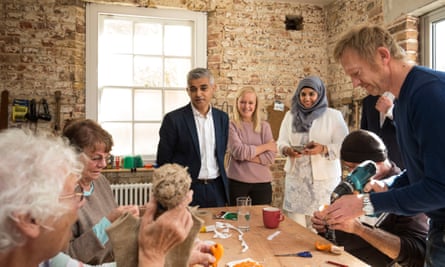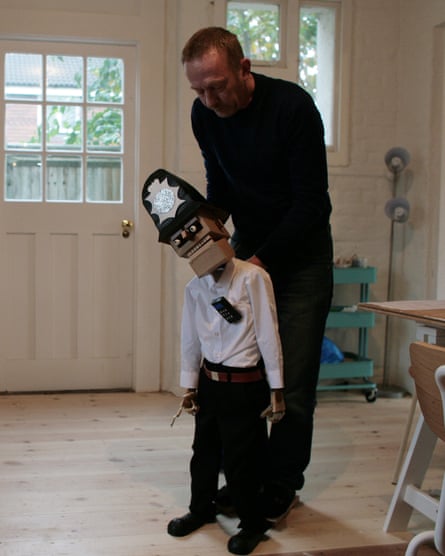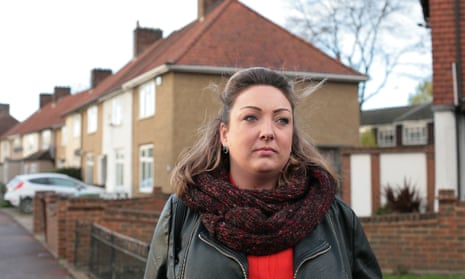‘The last thing this area needs,” snarls Ravinder Atwal, “is some middle-class film-maker reducing our community to a prose poem.” Her words come at the start of Patrick Goddard’s new film about Dagenham. Atwal’s in her VW campervan, driving Goddard to a car boot sale in the east London suburb so he can shoot some gritty footage of her trying to flog stuff to a pre-dawn crowd of geezers and lairy gents. He is sitting unseen in the passenger seat, filming her with a head-cam.
A prose poem may be the last thing Dagenham needs, but that’s what it gets. Called Tune Into Sanity FM!, the film opens with Goddard exploring the idea that artists are little better than locusts, descending on an area, plundering it for material while misrepresenting and exploiting the locals. He illustrates this tension through his odd-couple relationship with Atwal, the youth team leader and self-styled ‘modern witch’ he met shortly after taking up an artist’s residency in Dagenham. “Maybe you’re the carrot,” she snaps at one point. “That’s what I’m saying.”
What Atwal means is that artists like Goddard are not to be trusted. They are often the shock troops of gentrification. They set up studios in cheap, rundown areas and then what happens? Thanks to their visionary repurposing of the seemingly irredeemably abject, within a few years rents and house prices are soaring. Locals are squeezed out and in come the craft ale brewers and coffee-roasters who recline in their Eames chairs hoping their rebranded locale will achieve its ultimate validation: a branch of Whole Foods.
Could this gentrification nightmare be Dagenham’s fate, now that socially concerned artists are moving in? That’s what Goddard’s film worries about. From the passenger seat of Atwal’s VW, we hear the whine of the guilt-ridden, self-loathing, middle-class film-maker. “I don’t want to be the carrot,” he says.
I’m sitting with Goddard looking at rough footage of his film in a converted farmhouse called the White House in Dagenham’s Becontree estate. It’s here that Create – an organisation set up in 2008 to connect artist communities and local people in east London – has launched its latest venture. The dilapidated building, for which the local council couldn’t find a purpose, has been converted by architects Apparata into a place where these two camps can meet.

“Plonking artists right in the middle of a council estate might demystify what it is they do,” says Create’s director Hadrian Garrard, over tea in the lounge. “We want to demonstrate that artists can make positive contributions to the lives of people, rather than be tools to drive them out.” Garrard tells me London is full of artists – an estimated 13,000 in 2008 and doubtless more now – but he worries that few connect fundamentally with the lives of its everyday citizens, especially in places like Dagenham.
Kathrin Böhm, an artist Create commissioned to work in the area in 2014, discovered that many older locals had spent happy childhood summers hop-picking in Kent, as described by George Orwell in his 1935 novel A Clergyman’s Daughter. That source of income ended when hop-picking became mechanised in the 1960s.
So Böhm decided to tap into the nostalgia some residents felt for those golden summers by taking them back to pick hops in the old style and make craft beers and juice, which they sold through a social enterprise called Company Drinks. When her project was reported in the Guardian, the inevitable headline was: Hopsters meet hipsters. Three years on, the hopsters are still meeting hipsters: Gerrard tells me proudly that 3,000 litres of drinks were sold at the Frieze art fair in London this year, while Böhm emails me a photo of its latest range.
Last year, Turner Prize-nominated artist Marvin Gaye Chetwynd created a decidedly bling soft play centre for the area, an ironic reappropriation of the soul-crushing dismalness of such places. “Her art is normally seen only in a gallery context, at Sadie Coles HQ in the West End,” says Garrard. “So it was refreshing for her to work outside that, with something that creates a little social capital.” As for Chetwynd, she said: “I’m more excited about this project than I have been about anything since having a baby.”

Goddard is one of two artists working with Create, which counts among its backers Bloomberg Philanthropies, Bank of America Merrill Lynch and the Paul Hamlyn Foundation. The other is Chad McCail, who will shortly premiere a pantomime he’s helped residents write, direct and perform in. McCail has also assisted with making puppets for the production, which is called Jack, Jill and the Beanstalk and will show at Dagenham Civic Centre.
Is it, I ask with trepidation, a socialist panto? “In a way,” says the Lanarkshire-based painter. “But I’m more of an anarchist than a socialist.” Is that what Dagenham needs this Christmas? Oh yes, he insists. “Disney bowdlerised the fairytales. We’re trying to restore them to their original power. Who was the giant in Jack and the Beanstalk? He would have been some rapacious landlord. Now we’re making a new version in which the giant, who eats people, stands for the big corporations not so very far from here.” You don’t mean, I ask, the masters of the capitalist universe 20 minutes down the railway line at Liverpool Street? He most certainly does.

McCail has already helped create This Used to Be Fields, a rather lovely mural depicting scenes from the Becontree estate’s past and present. “Elderly white ladies and Eritrean refugees were working on it with me,” he says. It’s an achievement he’s particularly proud of, given the area’s shabby recent past of racism.
As for his pantomime, one of his collaborators was Christina Ford, single mum, former teaching assistant and actor from Dagenham. Ford’s story is the perfect illustration of what the White House stands for. Thanks to the confidence working on the panto has given her, Ford is now planning to make a piece of scripted theatre about lone mothers compiled from interviews with women in the area. “It’s something I’ve wanted to do since 2011,” she says. “It’s really needed.”
Ford’s whole family have taken advantage of the creative opportunities the White House offers: her mother has been making felt toys and her son Jimmy, though only 11, has been giving history tours of the estate. “It’s really provided a space for me to grow,” says Ford. Just possibly, when the interloping artists in residence leave, locals will have enough creative savvy to run the White House themselves.
As I wander back through Dagenham, I notice that Chadwell Heath train station is on the new high-speed Crossrail route, due to open next spring. It’s just the kind of infrastructure upgrade that could get City types moving in to this manor. And what might make Dagenham seem more attractive is that the artists, albeit socially concerned ones, have already moved in. Maybe Ravinder Atwal is right to worry.
- Jack, Jill and the Beanstalk is at Dagenham Civic Centre, 9 and 10 December. Tune in to Sanity FM! will be screened at Eastbury Manor, Barking, on 14 December.

Comments (…)
Sign in or create your Guardian account to join the discussion